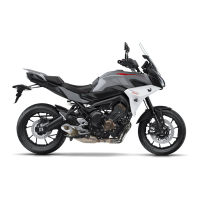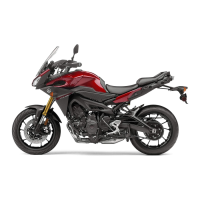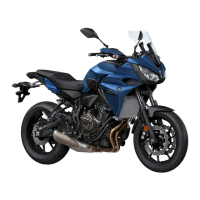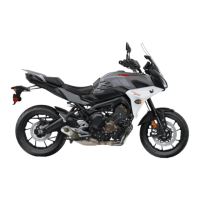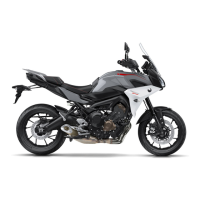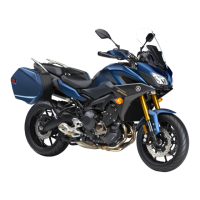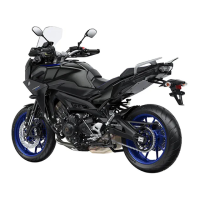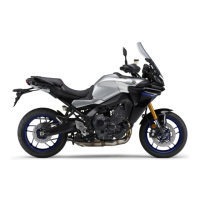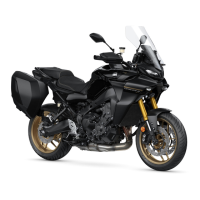
Do you have a question about the Yamaha TRACER MT09TRA and is the answer not in the manual?
| Displacement | 847cc |
|---|---|
| Transmission | 6-speed |
| Bore x Stroke | 78.0 mm x 59.1 mm |
| Compression Ratio | 11.5 : 1 |
| Fuel System | Fuel Injection |
| Starter System | Electric |
| Final Drive | Chain |
| Engine Type | Liquid-cooled, 4-stroke, DOHC, 4-valve, inline 3-cylinder |
| Power | 84.6 kW (115 PS) @ 10, 000 rpm |
| Torque | 87.2 Nm @ 8, 500 rpm |
| Fuel Capacity | 18 liters |
| Brakes | Hydraulic dual disc, Hydraulic single disc |
| Tires | 120/70ZR17 front, 180/55ZR17 rear |
| Maximum Power | 84.6 kW (115 PS) @ 10, 000 rpm |
| Maximum Torque | 87.2 Nm @ 8, 500 rpm |
| Frame | Diamond |
| Front Brake | Dual 298mm discs |
| Rear Brake | Hydraulic single disc, Ø 245 mm |
| Front Tire | 120/70ZR17 |
| Rear Tire | 180/55ZR17 |
| Wheelbase | 1, 440 mm |
Essential guidelines for safe motorcycle operation and awareness of hazards.
Details on necessary riding gear to prevent or reduce injuries during accidents.
Guidelines for adding cargo or accessories to maintain vehicle stability and handling.
Identifies key components and their locations on the left side of the motorcycle.
Identifies key components and their locations on the right side of the motorcycle.
Overview and location of the motorcycle's primary controls and instruments.
Explanation of the anti-theft system, including key usage and precautions.
Description of dashboard indicator lights and their meanings for vehicle status.
Details on the digital display unit, including speedometer, tachometer, and other information.
Information about the Anti-lock Brake System, its operation, and warnings.
Explanation of the TCS function, settings, and operation for improved grip.
Checks for fuel level, lines, and hoses to ensure safe operation before riding.
Procedures for checking engine oil level and for potential oil leaks.
Checks for brake operation, fluid level, pads, and hydraulic system integrity.
Inspection of tires for damage, tread depth, and correct air pressure.
Step-by-step instructions for safely starting the motorcycle's engine.
Guidelines for the initial period of engine use to ensure longevity and performance.
Instructions and warnings for safely parking the motorcycle.
Comprehensive schedule for routine checks, lubrication, and part replacements.
Procedures for checking, changing engine oil, and replacing the oil filter.
How to check brake fluid levels and precautions for maintaining braking performance.
Guidance on diagnosing and resolving common motorcycle issues.
General advice on cleaning and maintaining the motorcycle to preserve its appearance and function.
Instructions for properly storing the motorcycle for short-term and long-term periods.
Technical specifications related to the motorcycle's engine, including displacement and bore/stroke.
Details on the motorcycle's electrical components, including battery and lighting.
Specifications for the motorcycle's front fork and rear shock absorber system.
Location and importance of vehicle and engine identification numbers for registration and parts.
